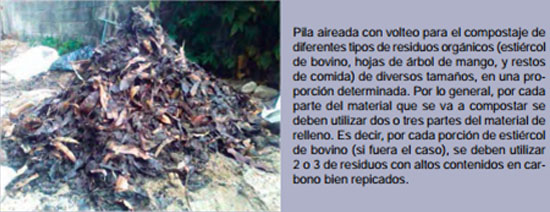Design of a module for the composting of small amounts of organic waste
Abstract
Composting is a dynamic process carried out by the combined activity of a wide variety of microbial populations (Gray and Biddlestone, 1973). These populations act in an environment of relatively limited duration, where each one actively intervenes in the decomposition of organic materials, mainly requiring carbon and nitrogen for their development. Cegarra (1998) points out that low values of the carbon/nitrogen (C/N) ratio delay the composting process and increase the loss of nitrogen. On the contrary, initial values greater than 35 promote numerous cycles of activity of the microorganisms with greater delay in the process. Consequently, it is estimated that 25 times more carbon than nitrogen is necessary for microbial activity, with optimal C/N values being considered around 25 in the original materials. Composting is completed when the C/N ratio is reduced by this microbial action to approximately 10/1; which is equivalent to the C/N ratio of soil humus.
References
Cegarra, J. 1998. Residuos Orgánicos. Aprovechamiento agrícola como abono y sustrato. 2da edición ampliada y corregida. Editores: Nelson Walter Osorio V. Y Francisco Hernando Orozco P. Medellín, 1571 p.
Emison 2015. Compostaje. Disponible en línea: http:// www.emison.com/511.htm [01 de noviembre de 2015].
Gómez, J. y S. Pérez. 2008. Efectos sobre el cultivo de rabanitos rojo (Raphanus sativum L.) de tres fertilizantes orgánicos. Disponible en línea: http:// www.agroecologia.net/recursos/publicaciones/publicaciones-online/2009/eventos-seae/cds/congresos/actas-bullas/seae_bullas/verd/posters/9%20P.%20FER/fer6.pdf [01 de noviembre de 2015]
Gray, K. and A. Biddlestone. 1973. Composting. Process Parameters. The Chemical Engineer. 15: 71-76.
Millner, P. 2003. Composting: Improving On a Time-Tested Technique, Disponible en línea: http://www.ars.usda.gov/is/AR/archive/aug03/time0803.htm [10de diciembre de 2003].
Ostos, A. 1993. Diagnóstico de la propiedades del suelo que afectan el desarrollo de plantas de cítricas en el lote E sector este del campo experimental de la Facultad de Agronomía de la UCV. Tesis de grado. Facultad de Agronomía de la Universidad Central de Venezuela. Maracay, Venezuela. 87 p.
Paul, E. and F. Clark. 1996. Soil Microbiology and Biochemistry. 2 ed. Academic Press. 340 p.
Ramírez, R. y M. Pérez. 2006. Evaluación del potencial de los biosólidos procedentes del tratamiento de aguas residuales para uso agrícola y su efecto sobre el cultivo de rabanitos rojo Raphanus sativum L.). Revista de la Facultad Nacional de Agronomía. Colombia, Medellín. 59 (2): 3543-3556.
Tiquia, S.; N. Tam and I. Hodgkiss. 1998. Changes in chemical properties during composting of spent pig litter at different moisture contents. Bioresource Technology. 67: 79-89.


